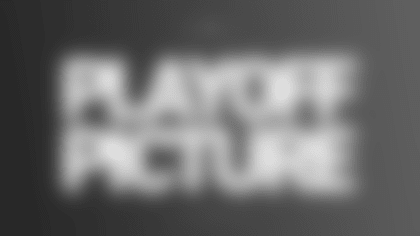They'll provide the most recent information each team has on the players available in this year's NFL draft, but putting too much weight on scouting combine results and personal workout performances can cause teams to make critical draft-day mistakes.
Need proof? Then consider players such as Mike Mamula, Kyle Boller, Kevin Jones and Ben Roethlisberger.
Mamula is the all-time example of what teams should guard against at the Indianapolis scouting combine. Mamula, an undersized defensive end from Boston College, "jumped out" of the RCA Dome in his combine workout. He turned in one of the best "underwear practices" in NFL history. That performance, combined with the premium teams place on pass-rushers, caused the Philadelphia Eagles to make Mamula the seventh player chosen in the 1995 draft. The career that followed, however, made Mamula a legendary bust.
Boller is another of those workout wonders. He's got all of the physical tools and he displayed them brilliantly in his personal workout for teams prior to the 2003 draft. Baltimore bought the goods Boller was selling and the Ravens made Boller the 19th pick of that draft. Two years into his career, however, most believe Boller is headed toward a disappointing career.
In contrast, Roethlisberger didn't perform especially well at last year's combine. His passes lacked accuracy and there were concerns for his deep-ball arm strength, which caused him to slip to 11th in the draft. Obviously, the scouts weighed Roethlisberger's combine performance too heavily. He was 14-0 as a starting quarterback as a rookie for the Steelers last season, before losing to Tom Brady and the Patriots in the AFC title game.
Then there's Jones, who had a brilliant career at Virginia Tech. He was considered to have great speed and quickness for a running back, but he timed poorly in his personal workout. What happened? Well, Jones is a football player, not a track guy, and he made the mistake of lifting his hand off the ground before he moved his feet. Scouts traditionally start their watches with first movement, and that made Jones a 4.6. If they had started their watches when he first moved his feet, he would've clocked considerably faster. That information, apparently, was ignored by most teams looking for a running back. Jones lasted until the 30th pick. Now, after a sensational rookie season, Jones is the future of the Lions' offense.
What all of that means is that scouts make mistakes. They're only as good as the information available to them, and the February scouting combine and the March and April personal workouts provide the most recent information scouts are able to acquire. How do you ignore what you've seen?
"It originated to get medicals on the top players in the country," Jaguars Director of College Scouting Gene Smith said of the scouting combine. "Then it went from that to skill-testing and those are now called combine drills."
Officially, what we now refer to as the Indianapolis scouting combine began as the "National Invitation Camp" in 1978, in New York, with 105 players having been invited. The NIC moved to Tampa, New Orleans and Tempe, Ariz., before settling in Indianapolis in 1987.
Smith and the Jaguars – scouts and coaches – are in Indianapolis this week for the 2005 scouting combine. About 325 draft prospects are also there. They will be timed in the 10, 20 and 40-yard dashes. They'll do vertical and broad jumps; the short shuttle, the three-cone drill (no, not an ice cream-eating contest) and position drills. They'll be drug-tested, flexibility-tested, psychologically-tested and examined by an army of doctors. Then, during evening hours, those players will be escorted to the "team rooms" of those franchises who've requested personal interviews at the Indianapolis Crown Plaza Hotel. The Jaguars will conduct 60 such interviews.
So, what stock should a personnel department put on the scouting combine? And how about that personal workout, which is nothing more than an up-close-and-personal underwear practice?
"It helps us define or identify our takeable players. Our medical staff will put a grade on the player and that'll decide whether we take him or not. Our goal is to narrow it down to at least 100 takeable players. We come away with the medical alerts, the character alerts," Smith said.
"That's the tiebreaker," Smith added of how he uses the information from the combine and personal workouts. "The guy with the more clearly evident athletic ability has the ability to be a more ascending player."
As written in Part I of "Scouting 101," the Jaguars assemble their "initial stacking" of their "draft board" according to the information they've accumulated from the player's college playing career. The combine and personal workouts only tweak or massage that "draft board."
College programs provide for "pro days" when NFL scouts may observe that program's draft-eligible prospects perform in player-friendly workout conditions. The player will run on the fastest track the college can provide, which is another consideration scouts must take into account. A lot of the top prospects decline to run at the combine because the RCA Dome is not considered to be a time-friendly track.
"You want to see athletic ability, how they compete, how they look and how they follow instructions in a drill. It's a job interview," Smith said of the personal workout.
Miami's Kellen Winslow is a player who excelled in his personal workout last year. Cleveland became so enamored with Winslow that it unnecessarily gave away a second-round pick to trade up one spot to draft Winslow.
The bulk of the "pro days" are conducted in March. If a team is really hot on a guy, it may approach his agent with a request for another and more private workout session.
As April and the draft approaches, Smith and the Jaguars personnel department becomes more meeting oriented. It's time to begin formulating draft-day strategy. These are the final days, the final hours before draft day (April 23 this year), and all of the guesswork has to be eliminated.
Eventually, each player has to be given a final draft grade. It will determine where he fits on the Jaguars' "draft board." That grade will be determined by the following criterion: performance at his primary position, performance at a secondary position or in an additional role, character, competitiveness, football aptitude and medical status.
During the last week of March, Smith, Director of Player Personnel James Harris, coach Jack Del Rio and the coaching and personnel staffs massage their "draft board" according to the "pro-day" workouts.
In the first week of April, discussion is conducted on positional grade clusters, targeting especially strong areas of the draft that could result in runs at a position. A workout day is also conducted for Jacksonville natives who are draft-eligible.
The second week of April sees prospects the Jaguars are targeting and players who weren't invited to the combine make visits to Jacksonville.
Now we're in draft week. It's countdown time and the countdown begins with a Monday meeting that produces a final tweaking of the "draft board." Tuesday is dedicated to reviewing draft-day logistics. A mock draft including possible trade scenarios is conducted on Wednesday. Draft-day possibilities, focusing mostly on potential trades, occupy Thursday's conversations, and on Friday Smith and company present owner Wayne Weaver with a power-point presentation on the Jaguars' draft strategy.
All right, it's almost time to pick. Get a good night's sleep. See you in the morning.














